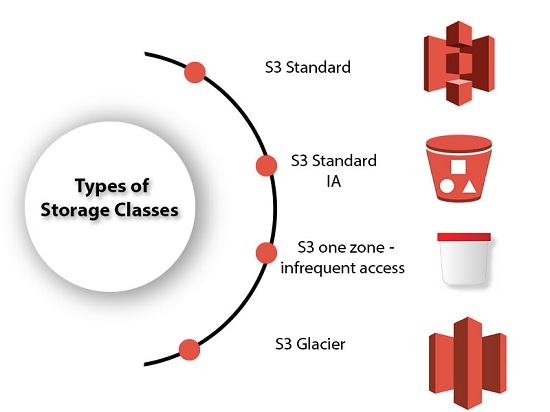AWS Storage Classes

- S3 storage classes are used to assist the concurrent loss of data in one or two facilities.
- S3 storage classes maintain the integrity of the data using checksums.
- S3 provides lifecycle management for the automatic migration of objects for cost savings.
S3 contains four types of storage classes:
- S3 Standard
- S3 Standard IA
- S3 one zone-infrequent access
- S3 Glacier
S3 Standard
- Standard storage class stores the data redundantly across multiple devices in multiple facilities.
- It is designed to sustain the loss of 2 facilities concurrently.
- Standard is a default storage class if none of the storage class is specified during upload.
- It provides low latency and high throughput performance.
- It designed for 99.99% availability and 99.999999999% durability
S3 Standard IA
- IA stands for infrequently accessed.
- Standard IA storage class is used when data is accessed less frequently but requires rapid access when needed.
- It has a lower fee than S3, but you will be charged for a retrieval fee.
- It is designed to sustain the loss of 2 facilities concurrently.
- It is mainly used for larger objects greater than 128 KB kept for atleast 30 days.
- It provides low latency and high throughput performance.
- It designed for 99.99% availability and 99.999999999% durability
S3 one zone-infrequent access
- S3 one zone-infrequent access storage class is used when data is accessed less frequently but requires rapid access when needed.
- It stores the data in a single availability zone while other storage classes store the data in a minimum of three availability zones. Due to this reason, its cost is 20% less than Standard IA storage class.
- It is an optimal choice for the less frequently accessed data but does not require the availability of Standard or Standard IA storage class.
- It is a good choice for storing the backup data.
- It is cost-effective storage which is replicated from other AWS region using S3 Cross Region replication.
- It has the same durability, high performance, and low latency, with a low storage price and low retrieval fee.
- It designed for 99.5% availability and 99.999999999% durability of objects in a single availability zone.
- It provides lifecycle management for the automatic migration of objects to other S3 storage classes.
- The data can be lost at the time of the destruction of an availability zone as it stores the data in a single availability zone.
S3 Glacier
- S3 Glacier storage class is the cheapest storage class, but it can be used for archive only.
- You can store any amount of data at a lower cost than other storage classes.
- S3 Glacier provides three types of models:
- Expedited: In this model, data is stored for a few minutes, and it has a very higher fee.
- Standard: The retrieval time of the standard model is 3 to 5 hours.
- Bulk: The retrieval time of the bulk model is 5 to 12 hours.
- You can upload the objects directly to the S3 Glacier.
- It is designed for 99.999999999% durability of objects across multiple availability zones.
Performance across the Storage classes
| S3 Standard | S3 Standard IA | S3 One Zone-IA | S3 Glacier | |
|---|---|---|---|---|
| Designed for durability | 99.99999999% | 99.99999999% | 99.99999999% | 99.99999999% |
| Designed for availability | 99.99% | 99.9% | 99.5% | N/A |
| Availability SLA | 99.9% | 99% | 99% | N/A |
| Availability zones | >=3 | >=3 | 1 | >=3 |
| Minimum capacity charge per object | N/A | 128KB | 128KB | 40KB |
| Minimum storage duration charge | N/A | 30 days | 30 days | 90 days |
| Retrieval fee | N/A | per GB retrieved | per GB retrieved | per GB retrieved |
| First byte latency | milliseconds | milliseconds | milliseconds | Select minutes or hours |
| Storage type | Object | Object | Object | Object |
| Lifecycle transitions | Yes | Yes | Yes | Yes |

No comments:
Post a Comment